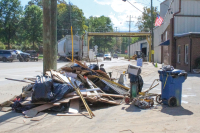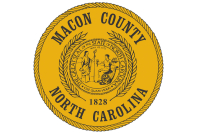Shared finances complicate MedWest partnership
Some within the Jackson County medical community are wondering whether their hospital has gotten a fair shake in the partnership forged with neighbor Haywood County under the MedWest umbrella two years ago.
When the hospitals in Haywood, Jackson and Swain counties partnered, they were careful to avoid the word “merger.” Technically, it was an affiliation, according to hospital leaders.
But at the end of the day, it looks an awful lot like what most people would call a merger. The hospitals share each others’ financial gain — or pain — as it may be.
“At the end of the year, we take the bottom line and split it 50-50,” said Mike Poore, the CEO of MedWest-Haywood.
The hospitals keep their own books from day to day, but come year’s end, the profits and losses of each are averaged out.
Steve Heatherly, the CEO of MedWest-Harris, calls it “financially integrated.” In slightly more layman’s terms, Bunny Johns, chairman of the WestCare board, likened it to a “financial truing up.”
Related Items
That’s likely why some in Jackson’s medical community may be resentful of big bucks seeming to fly out the door of MedWest-Haywood during the past year.
MedWest-Haywood has seemingly been on a building and spending spree during the past year — from the very necessary replacement of a broken down generator to the very optional construction of a new surgery center. Meanwhile, however, the medical community in Jackson has watched as its plans for a new emergency room and major hospital renovation has been sidelined.
“Any individual who is prone to analyze that very critically, sure someone could be upset by that,” Heatherly said of the spending disparities between Haywood and Harris.
But a partnership like this one can’t be sized up from a one-year snapshot, he said.
“When you put together in essence a capital plan with multiple facilities, in any one year it might be perceived that one of those facilities benefits more,” Heatherly said. “But over the long haul, the goal is to make sure the needs of all facilities are met.”
One day, the tables may be turned and likely will. Harris has jumpstarted plans once more for a new emergency room, which will likely carry a $7 million price tag.
Poore said the spending in Haywood has been necessary. In many cases, the hospital’s hand was forced. A generator broke down. A lawsuit was settled. Computer systems needed updating.
But, what about the surgery center, new hospice center or urgent care in Canton?
Johns said the picture isn’t as skewed as it may seem on the surface.
“Most of those were in place and moving before the merger,” Johns said.
But more so, what appears to be spending by the hospital was in fact paid for by outside sources. Doctors put up most of the money to build a new surgery center in Haywood, while the nonprofit MedWest-Haywood Foundation raised money for the hospice center. The hospital, for its part, contributed $2 million combined to those projects.
A new urgent care center coming on line in Canton is costing $150,000. But one was built in Sylva as well, evening the scales on that particular expense. Besides, an urgent care center is a case of spending money to make money. It helps capture patients.
Here’s the spending at Haywood in a nutshell:
• A hospice center, a new surgery center and a new urgent care are in various stages of construction, a total of $2.35 million.
• The back-up generator broke and a new one cost $1.3 million.
• Money has been put on the table to buy physician practices, bringing more than two dozen doctors on the hospital’s payroll in Haywood County.
• The biggest ticket item is an $8 million medical records system. While the biggest need for the new system stemmed from Haywood, the cost also includes upgrades for the hospitals in Jackson and Swain, as well as computer systems to tie in to the burgeoning number of in-house doctors practices across all three counties with the hospital system.
• Hardly the stuff of bragging rights — but expenses nonetheless — are payouts in two old lawsuits, roughly $1.75 million in all.
Bringing docs on the payroll
One expense weighted toward Haywood since the merger is the buyout of doctor practices.
Doctors nationally are cashing in the hassles of private practice for the steady paycheck of being a hospital employee. They no longer have the freedom of an entrepreneur, but they are free to simply practice medicine without worrying about the business side.
The transition has proven costly for hospitals, however.
“It is not an inexpensive proposition to employ physician practices,” Johns said.
The hospitals nor doctors will reveal exactly what it cost to buy the practice. But, the expense doesn’t stop there. The hospital has to assume payroll and overhead immediately, but there is a several month lag before billing catches up, putting a dent in the hospital’s cash flow.
Both WestCare and Haywood had fallen behind in the arena of employing doctors compared to the national trend, however. As doctors retired or moved away, the hospitals were struggling to attract new ones without being able to offer in-house employment.
“The traditional model of recruiting physicians into private practices was no longer working,” Heatherly said.
So starting five years ago, Heatherly led a campaign to bring doctor’s practices under employment of Harris.
“The potential loss of additional market share far outweighed the investment we needed to make,” Heatherly said. “The good news is we have been able to stabilize market share and now our focus has been to demonstrate to the community we are here and have an engaged group of physicians and employees who are very interested in meeting the health care needs in our community.”
Haywood, however, didn’t have that luxury.
While WestCare was on its aggressive campaign to employ doctors, Haywood was struggling to rebuild its image after failing federal inspections. The hospital was decertified and essentially closed its doors for five months in 2007.
It wasn’t exactly in a position to bring doctors onto its payroll. And doctors most likely weren’t going to sell their practices and go to work until they were sure the hospital was on solid ground.
And thus, it was catch up time.
“The pace of question activity certainly picked up over there,” Heatherly said of Haywood during the past 18 months.
Despite his WestCare roots, Heatherly is the first to admit it was worth the money to buy the doctors practices in Haywood County. The doctors were being courted by Mission Hospital, who was making forays to buy doctors practices in Haywood as part of a fight for market share. Heatherly said Haywood had to step in to protect its turf.
John Young, vice president for Carolinas HealthCare’s western region, also agrees with the move.
“If they hadn’t done it somebody else would have,” said Young, who works for the Charlotte-based hospital system that has a management contract over MedWest.
Perfect storm
Other things on the expense list simply couldn’t be helped — namely the lawsuits and blown generator.
“You have to have back-up generation for your hospital,” Young said.
The biggest financial hit by far was an $8 million system for electronic medical records. The expense was once again seen as spending on Haywood’s side of the ledger sheet, but it’s more complicated than that, Poore said.
When the hospitals partnered, each had a different computer system for electronic medical records.
WestCare’s was seen as the best system of the two, so Haywood had to ditch its system and start over. The cost includes some upgrades for WestCare’s portion of electronic medical records. The cost also includes bringing all the doctors employed by MedWest onto the system as well.
From Poore’s perspective, the expense was for all three hospitals.
Haywood also took a hit from two old lawsuits. Both date to the former hospital administration. One quite literally: the suit was filed by the former hospital administrator to pay out accrued vacation. The hospital settled for $150,000 in back pay.
The other was a $1.6 million judgment against the hospital in a suit filed by ER doctors wrongfully ousted at the hands of the former administration.
“It was before us, but in the end, you have to pay what you have to pay,” Young said.
But neither lawsuit was factored into the profits or losses split at year’s end. Those were backed out and kept on Haywood’s side, meaning Haywood took the whole hit of those rather than factoring them into the shared profits and losses.
Harris next in line
Harris’ turn is indeed next, hospital leaders promise.
Five years ago, Harris was in the throes of designing an ambitious $18 million expansion and renovation. Plans called for a new emergency room four times bigger than the current one, as well as major renovations and additions to various parts of the hospital.
But, the recession sidelined the plans.
“We found that health care is not recession proof,” Johns said.
Unfortunately, the project at Harris had to wait.
“We have been juggling a lot of priorities,” Johns said.
With those now out of the way, however, a new emergency room for Harris is now back on the table as the “top priority,” Johns said.
“The ED is at the very top of the list,” Heatherly agreed.
It won’t be as big as once hoped for — likely only doubling the size of the emergency room and minus the related hospital renovations, for a much smaller price tag of only $6 to $7 million.
Still, that’s a lot of money. It will take borrowing, and that can’t happen until Harris is able to improve its financial bottom line.
Heatherly said MedWest-Harris needs to show “some good, sustained financial results” before the project gets the final green light, so it is hard to say exactly when it will happen.
WestCare is already carrying $14 million in debt on its books dating to various expansions on both its Sylva and Swain a decade ago.
MedWest-Haywood, on the other hand, has only about $4 million in debt, recently assumed as a line of credit from Carolinas Health Systems, which has a management contract over MedWest.
The MedWest system had a profit margin of 0.8 percent last year. It is aiming for 1.1 percent this year.
While slim, it is only slightly below what most small or mid-sized hospitals are pulling in these days. The margins also include depreciation, which artificially deflate what the hospital actually made in hard cash at the end of the day.









